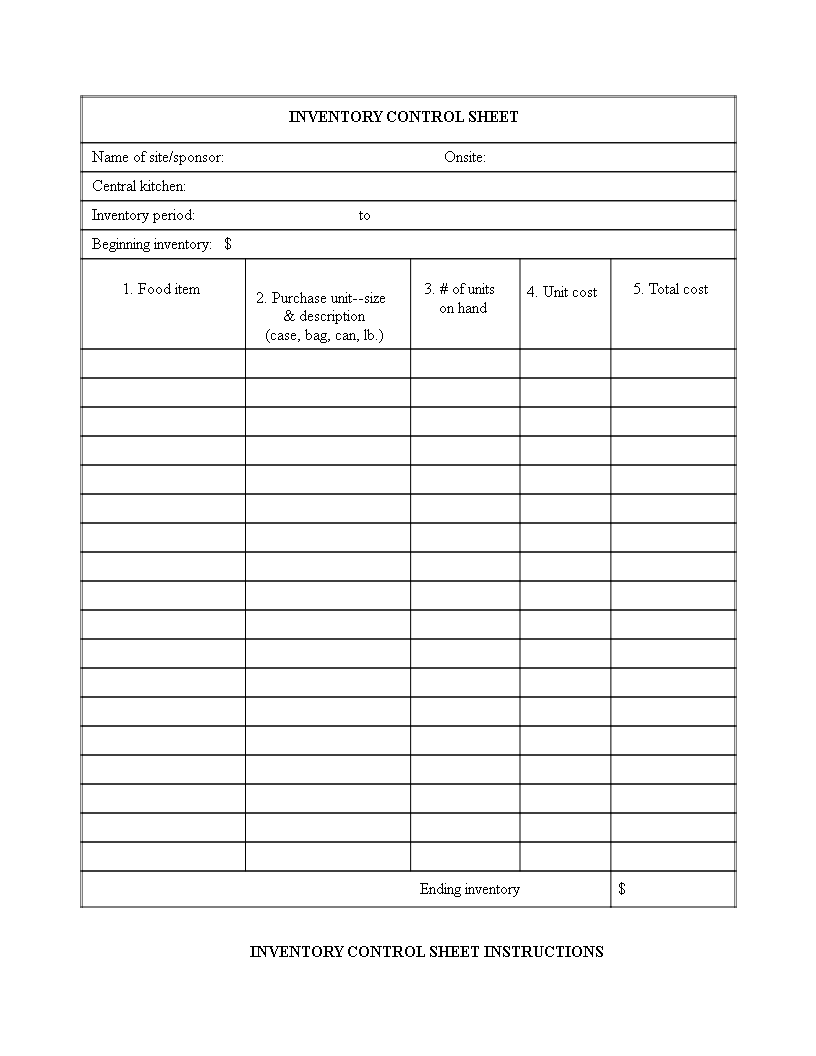Inventory Control Spreadsheet Food items
Sponsored Link免费模板 保存,填空,打印,三步搞定!

Download Inventory Control Spreadsheet Food items
微软的词 (.doc)免费文件转换
- 本文档已通过专业认证
- 100%可定制
- 这是一个数字下载 (58.5 kB)
- 语: English
Sponsored Link
What is the procedure for creating an inventory control sheet? How does an inventory control sheet work? What are its main components? Our inventory control sheet template is designed to help you track your food inventory and monitor your stock levels. Download this template now and keep track of all your food items.
We provide a template that will professionalize your way of communicating with employees. It enables them to improve their efficiency and effectiveness. Our templates are all in use by professional firms.
Save time, costs, and effort by using our templates!
An inventory control sheet, often referred to as an inventory control spreadsheet or inventory tracking sheet, is a document or electronic file used by businesses and organizations to monitor and manage their inventory. This tool helps track the quantity, location, and status of various items or products within a company's inventory. Here are the key components and functions of an inventory control sheet:
- Item Information:
- Item Name/Description: A clear and concise name or description of each inventory item.
- Item Code/Number: A unique identifier for each item, which can simplify tracking and organization.
- Quantity Information:
- Beginning Inventory: The initial quantity of each item in stock at the start of a specific period (e.g., month, year).
- Received: The quantity of items received from suppliers or through other sources during the tracking period.
- Sold/Consumed: The quantity of items sold to customers or used within the organization.
- Ending Inventory: The remaining quantity of each item in stock at the end of the tracking period.
- Location Tracking:
- Storage Location: Information about where each item is stored within the organization's facilities, such as a warehouse, shelf, or room.
- Bin/Shelf Number: A more detailed location identifier within the storage area, aiding in easy retrieval.
- Unit Cost and Total Value:
- Unit Cost: The cost of each item per unit (e.g., per piece, per unit of measurement).
- Total Value: The total value of the item's quantity in stock, calculated as the unit cost multiplied by the quantity.
- Reorder Point and Lead Time:
- Reorder Point: The minimum quantity of an item at which the organization should reorder to avoid running out of stock.
- Lead Time: The time it takes for new inventory to be delivered after placing an order.
- Supplier Information:
- Supplier Name: The name of the company or source from which the organization obtains the item.
- Supplier Contact Information: Contact details for the supplier, including phone numbers and email addresses.
- Notes and Comments:
- Space for additional information or comments related to each inventory item, such as special handling instructions or product notes.
- Date/Time Stamp:
- The date and, in some cases, the time when inventory transactions (e.g., receipt, sale) occurred.
- User/Employee Tracking:
- The name or identifier of the employee responsible for inventory transactions helps to track accountability.
- Status Indicators:
- Flags or symbols indicating the status of each item, such as "in stock," "out of stock," or "low stock."
Inventory control sheets are used to monitor stock levels, track usage, identify trends, and make informed decisions regarding restocking, order management, and inventory optimization.
We provide a template that will professionalize your way of communicating with employees. It enables them to improve their efficiency and effectiveness. Our templates are all in use by professional firms.
DISCLAIMER
Nothing on this site shall be considered legal advice and no attorney-client relationship is established.
发表评论。 如果您有任何问题或意见,请随时在下面发布
相关文件
Sponsored Link

